 |
| |
MI6 caught up with 'The James Bond Archives' editor Paul Duncan to chat about his stewardship of the fantastic new book from Taschen...
|
|
Taschen Archives Interview
14th November 2012
To celebrate 50 years of this innovative franchise, EON Productions opened their archives of photos, designs, storyboards, and production materials to editor Paul Duncan, who spent two years researching over one million images and 100 filing cabinets of documentation.
The result is the most complete account of the making of the series, covering every James Bond film ever made, beginning with "Dr. No" (1962) and ending with the upcoming "Skyfall" (2012), including the spoof "Casino Royale" (1967) and "Never Say Never Again" (1983). |
|
|
Datastream
Title: The James Bond Archives
Format: Hardcover
Pages: 600
Published: 26 Oct 2012
 Order (Taschen.com) Order (Taschen.com) | |
To celebrate the release of this impressive book, MI6 spoke to its editor, Paul Duncan, about the process of creating this book and his discoveries along the way.
How did Taschen become involved with the "James Bond Archives" project? How did the idea come together and at what stage of the process did you get selected as its editor?
I became involved with the project 12 years ago when I had my job interview with publisher Benedict Taschen. He said, “I've always wanted to do a big James Bond book,” so it was a dream project that we always had in the back of our minds. Then in the Autumn of 2009, Benedikt said we should think about doing the Bond book now, and it was agreed that he would contact producers Michael G. Wilson and Barbara Broccoli. A couple of months later I got a call from Jenni McMurrie at EON asking to meet to discuss a big book on Bond. We met at TASCHEN's London office and the first thing I asked Jenni was, “When did Benedict contact you?” But he hadn't. TASCHEN and EON had the same idea at the same time. It was a great moment of synchronicity. We knew the book was destined to happen.
TASCHEN had previously made large books on Stanley Kubrick, Ingmar Bergman and Pedro Almodóvar in our "Archives" series, where we had complete access the filmmakers' unpublished photos and manuscripts, so it was only natural that the James Bond book would be published in the same format. Everybody agreed immediately - it was a no-brainer.
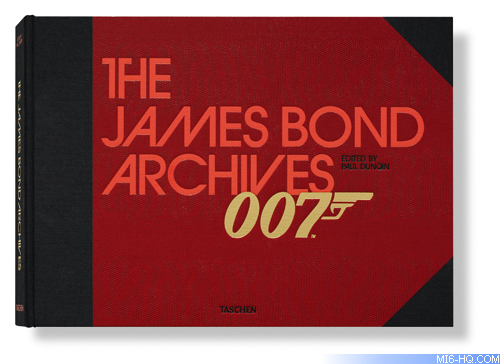
Above: Cover © 2012 Danjaq, LLC and EON Productions Limited, © 1962-2012 Danjaq, LLC and United Artists Corporation "James Bond" and "007 Gun Logo" are Trademarks of Danjaq, LCC, licensed by EON Productions Limited. All rights reserved. All other images ©1962-2012 DANJAQ, LLC and United Artists Corporation. All rights reserved.
|
How long have you been working on the project and what access to the EON archive did you have?
EON have so much material that they need several archives to hold everything! In 2010, I started visiting the photo archive to find out what was available, and what was appropriate for the book. Since our page size is 41 x 30 cm, which is rather large, I needed access to original negatives and transparencies to get the very best quality. I spent the whole year looking at contact sheets to make selections. If the contact sheets did not exist, I had to make selections directly from the negs. Meg Simmonds, who runs the archives, gave me every assistance and pointed me in the right direction, telling me stories about the shoots and giving me background information.
Nowadays, it is quite common for a stills photographer to take over 20,000 images over the course of a shoot, but in the 1960s they would take fewer, and I found that for some of the 1960s films there were much fewer than I would have anticipated. For example, for "Dr. No" there were probably no more than 2500 images taken by the unit photographers. Although there are contact sheets and prints of many of these, there are not many original negs. Meg told me that MGM also had original negs, so at the end of 2010, I spent two weeks in Los Angeles going through the MGM publicity files with Maggie Adams, and the MGM archives at the Academy Library with Matt Severson.
What I discovered is that for the early films EON selected 75 images for publicity, and then sent all their negatives to United Artists, who selected 75 images, and then the remaining negatives were either filed away, lost or junked. My job was to include the iconic images that everybody loved, and then to find other images that were not so common. This was not straight forward. In fact, I later discovered that one of the reasons there were so many images missing for "From Russia with Love" is because many of the rolls were developed on location in Istanbul, but the quality was so bad that they were returned to Turkey to offset customs charges. Then I found out that Mrs. Broccoli had kept almost 200 original colour transparencies in her archives. So it was a bad news/good news situation.
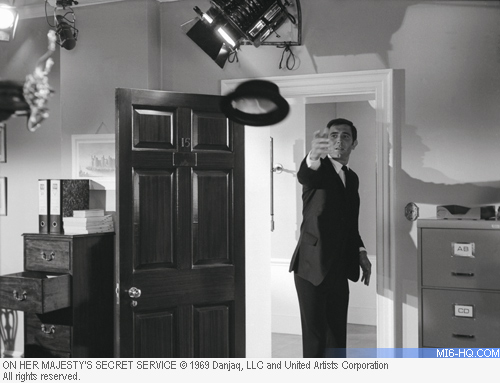
Above: George Lazenby as James Bond enters Miss Moneypenny's office during filming of On Her Majesty's Secret Service (1969). George Lazenby: "I could hit that hook every time with the hat. I'd just walk in, throw the hat, it'd land on the hook, and I'd say my dialogue. It was a piece of cake."
|
I should mention Greg Williams here, because he generously opened up his archive of on-set photos for the book, allowing me to select previously unpublished images for the layouts. I suppose the most surprising is one from Daniel Craig's screen test, which Daniel approved for this book only.
By the end of 2010, I had looked through every image in EON's photo archive - I lost count after I reached a million - so in 2011 I began looking through the paper archives - the concept art, storyboards, posters, and all the production documentation. EON have a warehouse full of this material, and this is where the work became much more involved and complicated.
For each film, I would start by looking for all the treatments, draft scripts, shooting scripts, script revisions, continuity scripts, and editor scripts. In this way, I could trace the development of the storyline, as well as the influence of the producers and directors up to the locked shooting script. Then I could see how the subtler script changes were made during shooting and on set.
The call sheets and progress reports for each day of filming showed me what was intended to be shot and what actually happened. The art department files were often the most illuminating because they took pictures during location scouting, or for reference during the shoot. Many of these files only exist because Peter Lamont kept everything in storage at Pinewood, just as John Stears did likewise with the props.
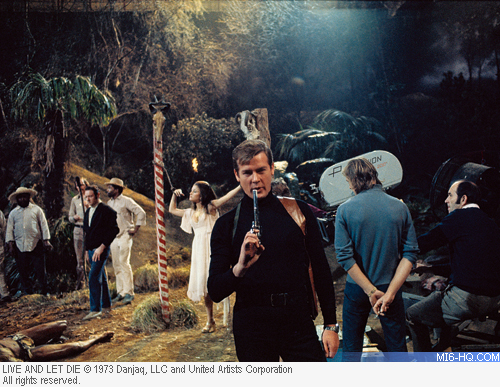
Above: Roger Moore as James Bond on the set of "Live and Let Die" (1973). Bond does not brandish a Walther PPK, but a Smith & Wesson Magnum, to rescue Solitaire (Jane Seymour, tied up in background). Though there was a great deal of pressure on him, Moore settled quickly into the role, showing the effortless élan that would become his signature.
|
So I had unrestricted access to every document in EON's archives, and almost every day I would find things that just blew me away, or added significant parts to the puzzle. For example, at the end of 2010, when I was looking through Danjaq's documents in Los Angeles, I found a reference to "Peak Productions," and this tied in with a folder of documents I found back in the UK - before EON and Danjaq existed, Cubby Broccoli and Harry Saltzman, as Peak Productions, had hired Wolf Mankowitz and Richard Maibaum to write the scripts for Dr. No and "Thunderball". It was only later in 1961, when EON and Danjaq were formed, that Peak Productions was dissolved. That lead to my investigation of Maibaum's original "Thunderball" script, which Cubby and Harry wanted to film - it was Fleming's current book - and had even made a breakdown of the filming in the British West Indies and Shepperton Studios. That was abandoned because of the suit between Ian Fleming and Kevin McClory over ownership of the story, but when Maibaum then moved over to rewrite the "Dr. No" script with Mankowitz, he also brought over the line "Bond, James Bond" (shortened from Fleming's "My name is Bond. James Bond") which had originally been in his "Thunderball" script.
So the archives are like one enormous jigsaw puzzle that I have tried to organise and present clearly in the book.
After visiting the EON archive did your plans change? How much did the material shape the book?
There are filing cabinets full of customs documentations, insurance forms, and movement orders, but the most interesting documents are the cables, telexes and faxes that were sent back and forth between the Pinewood office and the crew on location. It is in these documents that you really get a sense of what was happening, how the filming was progressing, what was going wrong, and how people were feeling. I found this absolutely fascinating, and would hunt through the documentation to follow people's stories to their resolution.
After I had seen this material, it seemed to me that the problem-solving aspect of filmmaking - having a limited time, budget and resources to make a big, complicated, logistical-nightmare of a movie - was the real story of the book. The making of a movie is a thriller situation in itself, full of suspense, action, and comedy, and I wanted to capture that.
I then came across the unedited interviews that John Cork and his team conducted for the Ultimate DVDs, as well as the on-set interviews and b-roll for each of the films. So this meant that not only did I have access to interviews for the whole series, but I had the documentation to back it up. I had presented "The Ingmar Bergman Archives" as an oral history, mostly from Ingmar's point of view, but I saw that this book would give me an opportunity to include the voices of many of the cast and crew who contributed to the series over the past 50 years by combining the interviews and documentation.
The first chapter I tackled as an oral history was "Goldfinger", and once the producers had read that, and understood my intent, they embraced it wholeheartedly. I wrote several of the chapters, and then contacted UK authors - some I had worked with before - to assemble and write chapters - Ellen Cheshire, Danny Graydon, Howard Hughes, Colin Odell & Michelle Le Blanc, and Jamie Russell. I supplied them with all the research materials they needed, gave them the best advice I could, then we rewrote and edited the texts until we had the correct tone and intent. In all, we have almost a quarter of a million words in the book, so it'll take a while to read.
Everything was read and approved by Barbara and Michael despite the fact that they were working on "Skyfall". They took the time to correct inaccuracies and misconceptions, as well as to add stories and information. At the same time, they laughed in recognition that some of the problems in past movies reflected problems they encountered on more recent movies. In the beginning I was surprised at their close involvement whilst being under such great pressure, but in the end I realised just how personal the films are to them, and was grateful for their input. The book could not have been made without them.
How did you go about planning the sections of the book that focused on the 23rd Bond adventure, "Skyfall", which was in production? How was collecting materials for this section different to the films that were already completed and archived?
Originally it was not my intention to have an oral history for every chapter. I wanted to reprint classic interviews and articles throughout the book because generating new texts is extremely time-consuming and fraught with difficulties when it comes to fact-checking. Each time I wanted to reprint an interview there would be a problem - they were often inaccurate, for example - so we would do an oral history instead. We had completed all the chapters up to "Licence to Kill", and I had selected interviews for all the Brosnan movies, but by this time Barbara and Michael had fallen in love with the oral history format, so we had to research and write those chapters, often using the on-set interviews for reference. The same thing happened with "Casino Royale" and "Quantum of Solace", but the difference was that the authors had access to crew members of those movies, who were very helpful in answering questions. Antony Waye spent a long time transcribing his diaries for us, which were a fabulous help, and Callum McDougall supplied us with the progress reports we needed.
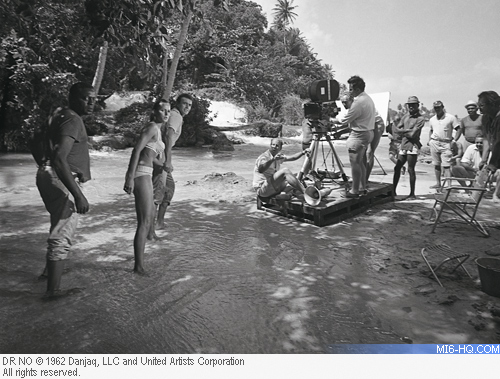
Above: On location in Jamaica filming Dr. No (1962), Terence Young is underneath the camera directing John Kitzmiller (Quarrel), Ursula Andress (Honey Ryder), and Sean Connery (James Bond).
|
I had very little time to write the "Skyfall" chapter as an oral history - I started when the pages of the book up to "Quantum" were already at the printer. Although I had heard some things about the production, I didn't know enough to write a whole chapter. EON moved into top gear: Gregg Wilson supplied me with the draft scripts I needed, Callum with production documents, Heather Banta with interview materials, and then I wrote and rewrote the chapter in 72 hours - I'm not sure I even slept!
You've been able to republish materials from other publications (Playboy, for instance), how did the idea come about and what was the process like seeking approval for non-EON materials?
For other TASCHEN books I have edited, like "The Godfather Family Album" and "Taxi Driver", I had reprinted articles and interviews from Playboy, Rolling Stone, and other magazines and newspapers, so it is not a problem to arrange this because these companies know TASCHEN and like our books.
Many non-Bond fans do not realise that the 1967 spoof "Casino Royale" and "Never Say Never Again" are not EON productions, so I wanted to include chapters on these productions. The producers had no problem with this. Images for "Never Say Never Again" are in the MGM archives, but I had a real problem with "Casino Royale". Eventually, I spent a day at the New York archives of special photographer Sam Shaw and found some great images there.
50 years of film history is a lot to contend with, as the editor what was your criteria for including content?
There is such a wealth of material in the archives that it would be very easy for me to make a 600-page book on each of the films. But I had to boil the material down to around 20-30 pages/6,000-12,000 words per film. My main concern was telling the story of how the film and story were developed, how the cast and crew interpreted that story, the practical and logistical considerations needed to make it happen, and then the final nerve-wracking introduction of the film to the public. It still amazes me that every single one of the films has made a profit. An astounding achievement.
Around this basic story thread, we tried to weave in amusing anecdotes and sad or exhilarating moments during the making of the films. For example, Joe Fitt and John Stears looking at the crew working with the model Vulcan in the Bahamas, then realising that the "rock" moving among them under the water is actually a shark. Or Terrence Young recounting the last, sad party with Pedro Armendériz. Or Richard Graydon whizzing down the icy cable from Piz Gloria, unable to stop himself. Or the chutzpah of George Lazenby forcing his way into EON to get the job of James Bond. Or Cubby Broccoli cabling Pinewood, telling them in no uncertain terms that they better finish the 007 Stage by the time they get back from Egypt.
In the end, it became about the people who made the movies, and showcasing their professional skill and vibrant personalities. For me, the book is about these human stories.
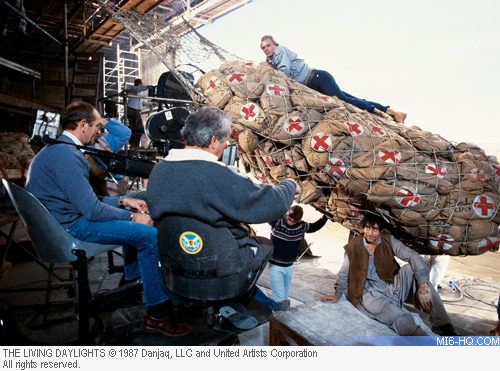
Above: The Living Daylights (1987): At Pinewood Studios Timothy Dalton (James Bond, under net) and Andreas Wisniewski (Necros, top of net) film close-ups of the fight to the death on the nets hanging from the back of the Hercules plane.
|
What was the most challenging aspect of creating the book? What did you learn that you were unaware of at the start of the project?
I was not at all knowledgeable about the background to the films, other than the occasional articles I had read in passing, so virtually everything was new and exciting for me. The most challenging part of the book was keeping it down to size. My long version of the "Goldfinger" text was 24,000 words, and it had to come down to 11,000 words, but most of the chapters were budgeted for 6,000 words. Likewise, with the images, I found many fabulous images that I just didn't have the space to include. I'm sure that EON will make use of these in the future.
Would you describe yourself as a James Bond fan and what specific elements of the franchise cry "Bond" to you?
I grew up loving Bond. My first one was "Diamonds are Forever", whilst on holiday. Then my dad took me to see "On Her Majesty's Secret Service" and "Thunderball" on a double bill. From "The Spy Who Loved Me" onwards, I made sure I saw all the Bond films as they came out at the cinema.
As a kid, it was always the cars, the gadgets and the big stunts that grabbed my attention. As I got older, the girls became somewhat more intriguing. Nowadays, I'm more interested in the character-driven aspects of the series. So it has been fun revisiting all the films for the book, and personally reassessing them from an adult perspective, but my attitude to the text has been to give a purely historical representation without opinion. So the book is not an analysis of Bond, but a documentary account of the making of the series.
The book offers a mixture of both film stills and candid behind the scenes shots, how did you address the balance you've created?
There are certain iconic moments that we had to include, like the corkscrew jump in "The Man With The Golden Gun". For that spread I had to find the original transparency for that shot so that we could have the jump as a full page. But I wanted to surround that image with background visuals. I found the map of the location that the production used to liaise with the local police in Bangkok, and a picture of the ramp being constructed by the crew, as well as Roger Moore congratulating stunt driver Loren “Bumps” Willert after the jump had been successfully completed. In this way I could try to cover the moment visually, as well as having the oral history to back it up.
As well as the stunt crew, I tried to include as many of the trades and technicians as I could throughout the book - makeup man John Rabiger painting Shirley Eaton in "Goldfinger", Chris Corbould putting compressed air bottles into Bond's car for the jump in "The Living Daylights", John Richardson driving the car holding the model Acrojet in "Octopussy", Ted Moore checking the light for "Thunderball", Alec Mills hanging from a wire in the wheelhouse to film George Lazenby in "On Her Majesty's Secret Service". Hopefully, by the end of the book, I will have covered the whole process of making Bond movies, from beginning to end. I would like the readers to feel that they are totally immersed in 50 years of Bond filmmaking.
Many thanks to Paul Duncan and Mark Best at Taschen.